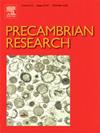Coupled Lu-Hf and U-Pb apatite geochronology of Jatobá orebody supports ∼ 2.5 Ga metamorphism in deep shear zones from southern Copper Belt, Carajás Domain, Brazil
IF 3.2
2区 地球科学
Q2 GEOSCIENCES, MULTIDISCIPLINARY
引用次数: 0
Abstract
A multi-isotopic geochronological study of apatite (U-Pb, Lu-Hf) in host basalts and mineralization from the Jatobá orebody, Southern Copper Belt, Carajás Domain, Brazil, constrains the age and setting of mineralization. Combined mineral textural relationships from cathodoluminiscence imaging, and compositional and isotopic data from EPMA and LA-ICP-MS, hint at initiation of an iron-oxide-copper–gold system at ca. 2.5 Ga during a deformation event linked to amphibolite facies metamorphism in deep (up to 20 km) shear zones. The ∼ 2.5 Ga Lu-Hf age is obtained from deformed, REE-rich cores of basalt-hosted apatite and is contemporaneous with metamorphism of a volcanic sequence deposited in a rift active during ca. 2.76–2.73 Ga. Some apatite grains retain a mafic, Cl-rich signature, testifying to a primary igneous origin. The Lu-Hf ages stretching from 2527 to 2384 Ma are obtained from apatite displaying textural diversity and geochemical heterogeneity, consistent with a prolonged event featuring dissolution-reprecipitation in response to fluid release during the retrograde cycle. The U-Pb system displays a younger ∼ 2 Ga U-Pb apatite age indicating later re-equilibration. This age corresponds to post-uplift mylonitization of the host sequences. The newly documented ∼ 2.5 Ga age for mineralization in a deposit from the southern Copper Belt is coeval with Cinzento Shear zone reactivation in the northern copper belt, and the ages of deposits like Salobo. Fluid flow along shears leached metals from the Mesoarchean basement, later deposited as sulphides intimately associated with the reworked apatite. We propose deep-rooted connections between mineralizing systems across the region.
巴西Carajás南铜带深部剪切带jatob矿体Lu-Hf和U-Pb耦合磷灰石年代学支持~ 2.5 Ga变质作用
巴西Carajás南铜带jatob矿体中寄主玄武岩中磷灰石(U-Pb, Lu-Hf)的多同位素年代学研究和成矿作用约束了成矿年龄和背景。结合阴极发光成像的矿物结构关系,以及EPMA和LA-ICP-MS的成分和同位素数据,表明在深部(达20公里)剪切带的一次与角闪岩相变质有关的变形事件中,在约2.5 Ga时形成了铁-铜-金体系。~ 2.5 Ga的Lu-Hf年龄来自于玄武岩磷灰石的变形、富ree岩心,与约2.76-2.73 Ga活跃裂谷中沉积的火山层序的变质作用是同时期的。一些磷灰石颗粒保留了基性的、富cl的特征,证明了原生火成岩的起源。在2527 ~ 2384 Ma范围内,磷灰石的Lu-Hf年龄表现出结构多样性和地球化学非均质性,与逆行周期中流体释放的溶蚀-再沉淀反应相一致。U-Pb系统显示较年轻的~ 2 Ga U-Pb磷灰石年龄,表明后来的再平衡。这一时代对应于寄主层序的隆升后糜棱石化。新记录的南铜带某矿床成矿年龄为~ 2.5 Ga,与北铜带Cinzento剪切带的再活化和Salobo等矿床的年龄一致。流体沿着剪切带从中太古代基底中浸出金属,随后以硫化物形式沉积,与改造后的磷灰石密切相关。我们提出了整个地区矿化系统之间根深蒂固的联系。
本文章由计算机程序翻译,如有差异,请以英文原文为准。
求助全文
约1分钟内获得全文
求助全文
来源期刊

Precambrian Research
地学-地球科学综合
CiteScore
7.20
自引率
28.90%
发文量
325
审稿时长
12 months
期刊介绍:
Precambrian Research publishes studies on all aspects of the early stages of the composition, structure and evolution of the Earth and its planetary neighbours. With a focus on process-oriented and comparative studies, it covers, but is not restricted to, subjects such as:
(1) Chemical, biological, biochemical and cosmochemical evolution; the origin of life; the evolution of the oceans and atmosphere; the early fossil record; palaeobiology;
(2) Geochronology and isotope and elemental geochemistry;
(3) Precambrian mineral deposits;
(4) Geophysical aspects of the early Earth and Precambrian terrains;
(5) Nature, formation and evolution of the Precambrian lithosphere and mantle including magmatic, depositional, metamorphic and tectonic processes.
In addition, the editors particularly welcome integrated process-oriented studies that involve a combination of the above fields and comparative studies that demonstrate the effect of Precambrian evolution on Phanerozoic earth system processes.
Regional and localised studies of Precambrian phenomena are considered appropriate only when the detail and quality allow illustration of a wider process, or when significant gaps in basic knowledge of a particular area can be filled.
 求助内容:
求助内容: 应助结果提醒方式:
应助结果提醒方式:


